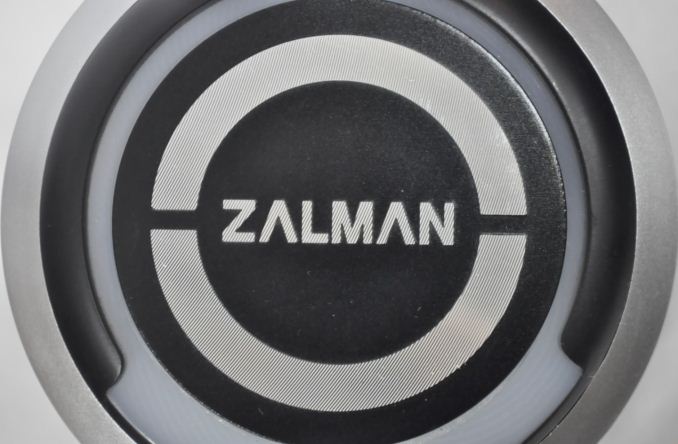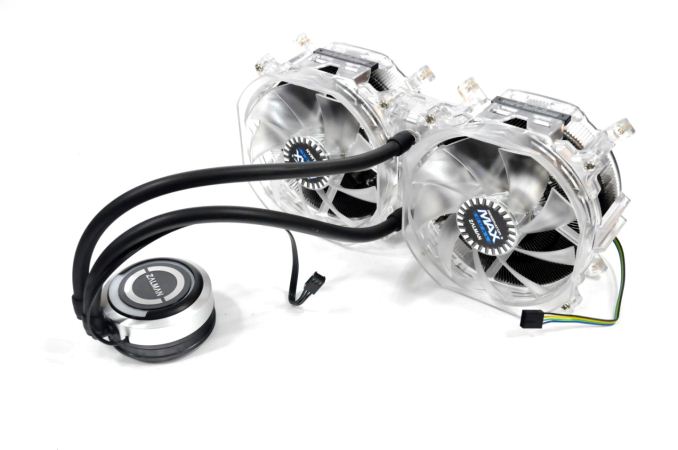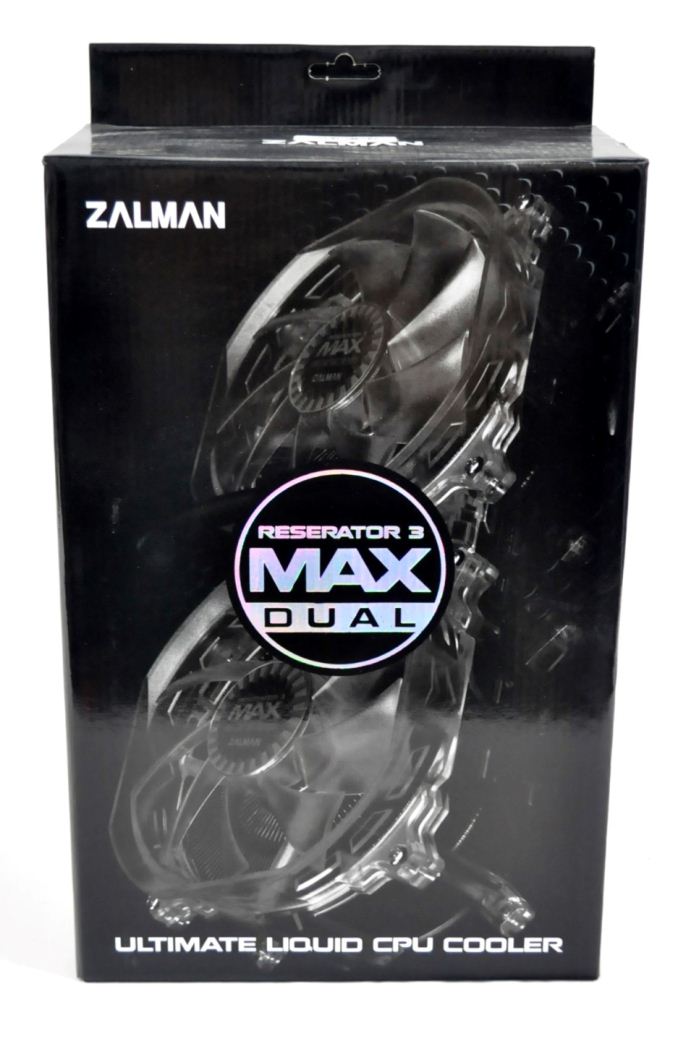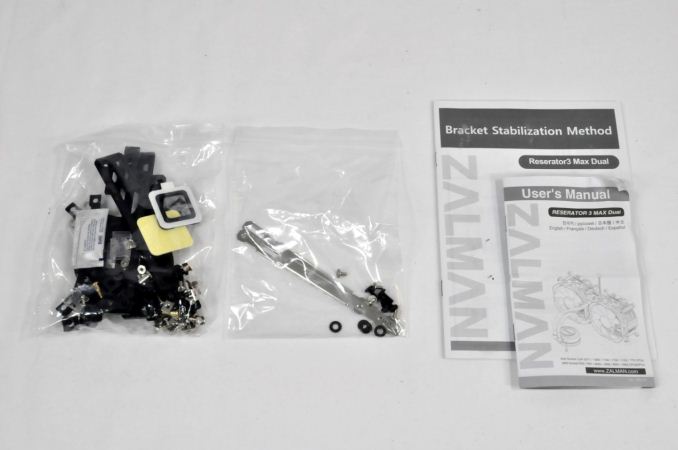Zalman Reserator 3 Max Dual CPU Cooler Review
by E. Fylladitakis on August 19, 2014 6:00 PM EST
Introduction
A few months ago, we had a look at many all-in-one liquid cooling solutions, ranging from low cost solutions to enthusiast-grade products. However, regardless of their size and capabilities, all of those kits were quite similar to each other. Today we have something that truly stands out from the crowd, Zalman's latest liquid-cooling solution, the Reserator 3 Max Dual.
Zalman's engineers are no amateurs when it comes to liquid cooling; they actually are one of the first companies that shipped liquid cooling solutions as complete retail products, so they have extensive experience in that particular field. The Reserator 3 Max Dual is being advertised as the "Ultimate Liquid CPU Cooler" and it currently retails for $140 including shipping, making it one of the most expensive all-in-one solutions available. It's clearly aimed at overclockers and enthusiasts, but is Zalman's newest creation worthy of such a heavy title and premium price? We will find out in this review.
Packaging and bundle
We received the Reserator 3 Max Dual in a large, dark cardboard box with little aesthetic appeal, as the artwork is based on a picture of the radiator. Blister plastic packaging protects the cooler inside the box. The bundled items are supplied into two plastic bags, entirely unorganized. Besides the hardware required for the mounting of the cooler and the instruction manuals, Zalman does not provide anything else. The thermal paste is the weak link of the bundle, as only a single dose of average thermal paste is supplied, when most users would expect at least a small syringe with high-quality thermal paste with such a premium product.













52 Comments
View All Comments
tuxfool - Wednesday, August 20, 2014 - link
Let me know when you can swap standard parts from a Mac Pro. It sure is nice, but it isn't particularly expandable...kwrzesien - Tuesday, August 19, 2014 - link
I'm using the H100i myself on the i7-4930K overclocked to 4.5 GHz, so it is probably pushing about 150W under most loads. Cores are hitting 73-78C which I'm fine with and PWM fans are slightly audible but still an enjoyable air-whooshing noise, just enough to know its doing something but not working too hard at it. So I was already wondering if next time around I should look at the 105, 110 or something else - but these charts pretty much say no. The H100i is super-easy to install and fits pretty much any case that tries to handle dual radiators. Even in my Corsair 350D, which could handle the 110, I like having a little room to route cables. I can't see any gains here worth upgrading for, in fact better fans on the 100i would probably match the stock 110 results.jibz - Tuesday, August 19, 2014 - link
How dare they tarnish the good name of Reserator! I still have my Reserator 2 in a box somewhere (the pump stopped working years ago), and I still like it even tho I stubbed my toes on its metal fins numerous times.Frallan - Wednesday, August 20, 2014 - link
I agree - the Reserator 1 v2 is a monster I still use it and I acctually plan to purchase one more from a friend that has it unused for my rig (overclocking and crossfire warms the water up to fast to much). But the difference between that and this is enormous - the 1 v2 is passive and completly silent (I struggle to tell if its running with my ear against the tower in a silent room). This brings neither top of the class cooling nor silence - its just a fail.just my 0.02€
AnnihilatorX - Thursday, August 21, 2014 - link
That's because Reserator 1 has no fan, it is of course compeltely silent :)I still have my Reserator 2 XT, while it is nice it is perhaps a bit too bulky for my liking (same applies to Reserator 1). Another advantage of AIO coolers is that it is maintenance free. I have changed the fluid of my Reserator 2 5 times, and each time it is a hassle with the need to go out and buy deionised water. (No distilled water for sale in the UK)
garadante - Tuesday, August 19, 2014 - link
Also, I have a question for anyone who can answer. Why is it that according to these tests, most of these CLCs can handle a 340 watt cooling load without breaking 30 C delta T over ambient, yet in the real world you see much higher than this on the temperature of CPUs? According to this, even a massively overclocked 4930k should never break 60 C, but I'm almost certain most users get much higher temperatures than that with these CLCs. Is it because of thermal conductivity between all the intermediate layers between the silicon, paste/solder, IHS, thermal paste, and finally the heatsink/cooling block? Whereas with this testing setup only has the (apparently) copper pad where the heat is initially generated. What causes this significant discrepancy between this synthetic test and real world results?I have to wonder just how useful this new synthetic test setup is. Yes, its great for comparing the relative performance of CLCs but it's useless towards showing us real world temperatures we can achieve on actual chips. At least when you have a test bench with a 4930k running at mid 4 GHz, with ambient temperature recorded, you can see what sort of temperatures you can expect to achieve on your own. Because as mentioned above, looking at these results would make me think that if I take a Corsair H110 with the fans running at full speed and put it on my i5-2500k running at 4.5 GHz, the resulting heat load is roughly 100 watts which these results would point towards an extremely low delta T in the high single digit, low double digit range. But if I were to put an H110 on my CPU I would very probably get more around a 30 degree delta T or perhaps even 35 degree. Point being, I like these synthetic tests for comparing relative performance of CLCs in a controlled environment but I would really like a way to relate these results to actual loads. I really like Anandtech and consider your work here generally of very high quality, but I feel it's very disappointing to have to look pretty much anywhere else to find any sort of real world numbers in regard to cooling. I want to know what sort of temperatures I can expect before shelling out $100-120 on a CLC so I don't put that money down and only decrease temperatures 5 C over current temperatures when I'd expect 10-20 C.
garadante - Tuesday, August 19, 2014 - link
Correct me if I'm wrong but mounting methodology isn't discussed even once. What thermal paste is used? What curing time is allowed? And in the testing methodology it would lead the reader to believe that the testing results are directly translatable into maximum, worst case real world temperatures of their CPUs. This is absolutely not true as stated before. Take any of these CLCs that have a delta T of 20 C with a 340 watt load and put them on an overclocked -E CPU and your real delta T will be double that, even though the thermal load is significantly below 340 watts. I would love to see this amended and discussed in future reviews because some sort of link to real world performance or at least an acknowledgement that this testing is good for relative performance of CLCs and that's it would be appreciated.garadante - Tuesday, August 19, 2014 - link
Also, in this testing setup is the heat evenly generated throughout the heatblock? If so that's cause for question, because in CPUs the heat is focused in a comparatively small section towards the center of the IHS, giving the heatsink less surface area to actually transmit heat through.E.Fyll - Wednesday, August 20, 2014 - link
I am always testing all coolers with the included thermal paste, unless I specifically say otherwise and I would mention the reason why not to. The reason for this is simple; I only care about the products as stand-alone retail items. Trying to fathom every possible usage scenario and modification for each cooler would be an utter waste of time, I would come up with a cure for cancer long before that.The test results are perfectly valid and are meant to create a comparative basis for coolers. Yes, they will not tell you the exact temperature of your X CPU, but they will tell you which cooler is and will always be better than another. Besides, you have no idea what the thermal losses of your CPU actually are (no, they are not equal to its energy consumption or with its TDP value, they can be both lower and higher according to the setup, you need a specific device to measure it). Each CPU has an entirely different behaviour depending on over three dozens of factors and even the same exact CPU will report different in-die temperatures due to the nature of the temperature sensing method (it is not exactly perfectly accurate). I cannot possibly test every single CPU out there, let alone many different samples of each.
The heat is generated from a rod inserted vertically from the base of the copper block, therefore it is concentrated at the center of the block and extending outwards, much like a CPU. The difference is that the sensor which I am using extends across the surface of the block, meaning that it measures the average temperature of the entire surface, not the temperature at a concentrated point at the center of the setup. This is the prime difference between a real CPU and this setup; a real CPU has a very small, pinpointed sensor right where the generation of heat takes place. I could replicate that by placing a very small sensor at the point of the heating rod, but that would ultimately be inaccurate. What the cooler "sees", is the surface it is being mounted on. It does not care about your CPU core, your settings or anything else; it will simply draw energy away from the heatspreader it is in contact with. Whether the CPU itself can transfer the energy to the heatspreader fast enough or anything else, it is case-specific and not related to the actual capability of a cooler. If I were to test different CPUs at the exact same thermal energy output, they would all display different behavior - as a matter of fact, even several pieces of the same exact CPU would do the same exact thing. It goes without saying that I cannot possibly test every possible configuration but, even if I could, that would be meaningless, as the placement of the sensor in the CPU die would be what is controlling the results. I could be testing two CPUs with the exact same thermal energy output, measure the exact same thermal energy being transferred from the heatspreader to the cooler and be reading a difference of dozens of degrees between the two systems, just because they are using a different type of sensor or the sensor is just present at a different location inside the die. This is entirely inaccurate and unscientific, you cannot make any sort of reasonable conclusions based on such results, they would be fabricated. I would rather display the actual capability of each cooler, which is a constant regardless of the CPU it is being mounted on, than provide misleading sets of data.
So, to summarize, the results depicted in the review are far from useless. They display the actual capability of the cooler, regardless of the CPU or any other external factor. What would be useless is to provide "real data" using a "real CPU", which would be case-specific and misleading for users that do not possess the knowledge to realize that their systems cannot be directly compared.
Future upgrades may include a device that automatically calculates the °C/W by measuring the exact amount of thermal energy that has been transferred from the block to the cooler, with an integrated sensor at the center of the plate. It is a custom made and rather costly device but it will resemble a CPU even more closely. However, as I am also trying to upgrade our PSU, fan and pretty much all of our testing equipment as well, I cannot build Rome in a day.
garadante - Thursday, August 21, 2014 - link
You go through such great lengths to tell my why ever request I suggested or flaw in your testing protocol is wrong. That's just ridiculous. I know you're new to Anandtech, but we're a very diverse crowd here. There are many semi-casual people here who want to become informed regarding certain products as well as many very serious enthusiasts who want to know how various products perform under many conditions. Your testing protocol, quite simply put, only appeals to the very semi-casual readers. And that's being generous. How many consumers will buy a CLC and use it exactly as it comes out of the box? Some, to be sure, but anyone who researches various CPU cooling options will learn that thermal paste is important, and that the bundled thermal paste is quite often sub par. Purchasing a tube of cheap but quality thermal paste (such as the tried and tested Arctic Silver 5) isn't a stretch of the imagination at all, considering it's being paired with $100-160+ CLCs. While swapping fans out is something likely mostly enthusiasts would do, it's still something users would look into if the performance gains are there. Running 2 or 3 tests with each CLC for some different fans (for instance one fan with high static pressure, another with high flow rate, and another with a balance in between) would give invaluable data because it would show users what, if any gains a particular radiator experiences with certain fans. That's not unreasonable at all considering your target audience. But instead you create a 100% synthetic test that while true allows you to produce data such as C/W, is only valid for 100% out of the box CLCs, which seems like it misses the mark. You give data for enthusiasts to calculate the delta C for a particular wattage yet you refuse to admit the validity of and consider implementing an expanded testing protocol to look deeper into the real performance of each radiator (the thing you're really paying money for when you buy a CLC. Fans are cheap)? I've seen your other responses to people suggesting expanded testing procedures or ways to improve the procedure you currently follow, but you always get very defensive with the protocol you've chosen and often times do everything you can to explain in painstaking detail why the reader's suggestion is worthless. This isn't about pride or ego. You're creating content for a large audience that contains many enthusiasts and people very knowledgeable about the subject matter, as well as the semi-casual readers. Yet you produce reviews that are really only useful for the semi-casual reader, completing neglecting the huge fountain of knowledge that is your enthusiast and intellectual reader base. You certainly know a fair amount about how to go about building a reproducible CPU heatsink test bench. But you don't know everything. And many of your readers know quite a bit as well, and some even more than you. Dismissing their suggestions out of hand because of some justification on your part is very narrow minded and undermines the credibility and reputation of this wonderful site as a whole.You're new to working for Anandtech, and so you should know that you've joined a well established community. We welcome you gladly to do what you can to raise the standards here even higher, but you cannot expect to do things your way when its against what the community desires. Implementing many of the requests the readers here have made of you should be a trivial thing to strive for as an Anandtech contributor.